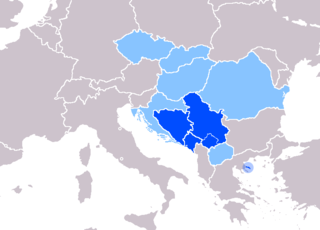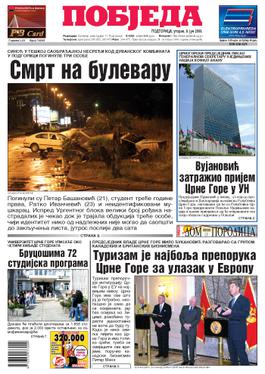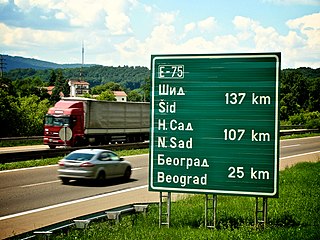Related Research Articles

Montenegro is a country in Southeast Europe. It is bordered by Bosnia and Herzegovina to the north, Serbia to the northeast, Kosovo to the east, Albania to the southeast, and Croatia and the Adriatic Sea to the northwest with a coastline of 293.5 km. Podgorica is the country's capital and its largest city. It covers 10.4% of Montenegro's territory of 13,812 square kilometres (5,333 sq mi), and is home to roughly 31% of its total population of 621,000. Cetinje is the former royal capital and cultural centre of Montenegro and is the location of several national institutions, including the official residence of the President of Montenegro.

Serbo-Croatian – also called Serbo-Croat, Serbo-Croat-Bosnian (SCB), Bosnian-Croatian-Serbian (BCS), and Bosnian-Croatian-Montenegrin-Serbian (BCMS) – is a South Slavic language and the primary language of Serbia, Croatia, Bosnia and Herzegovina, and Montenegro. It is a pluricentric language with four mutually intelligible standard varieties, namely Serbian, Croatian, Bosnian, Montenegrinand their subdialects. Serbo-Croatian is divided into three basic supradialects: Shtokavian, Kajkavian and Chakavian.

Serbian is the standardized variety of the Serbo-Croatian language mainly used by Serbs. It is the official and national language of Serbia, one of the three official languages of Bosnia and Herzegovina and co-official in Montenegro and Kosovo. It is a recognized minority language in Croatia, North Macedonia, Romania, Hungary, Slovakia, and the Czech Republic.
Montenegrin is a normative variety of the Serbo-Croatian language mainly used by Montenegrins and is the official language of Montenegro. Montenegrin is based on the most widespread dialect of Serbo-Croatian, Shtokavian, more specifically on Eastern Herzegovinian, which is also the basis of Standard Croatian, Serbian, and Bosnian.

Gaj's Latin alphabet, also known as abeceda or gajica, is the form of the Latin script used for writing Serbo-Croatian and all of its standard varieties: Bosnian, Croatian, Montenegrin, and Serbian.

Borba was a newspaper published in former Yugoslavia and Serbia, best known from the period when it was the official gazette of the League of Communists of Yugoslavia (LCY) until 1954 and Socialist Alliance of Working People of Yugoslavia thereon until its dissolution. Its name is the Serbo-Croatian word for 'struggle' or 'combat'.

The Serbian Wikipedia is the Serbian-language version of the free online encyclopedia Wikipedia. Created on 16 February 2003, it reached its 100,000th article on 20 November 2009 before getting to another milestone with the 200,000th article on 6 July 2013, and then another milestone with the 500,000th article on 13 January 2018.

Pobjeda is a Montenegrin daily newspaper. Having been published for 75 years, it is the oldest Montenegrin newspaper still in circulation; in the media, it is also the oldest Montenegrin active publication. Until September 1997 it was the only daily newspaper printed in Montenegro. On 21 May 2010, the newspaper dropped the Cyrillic script in favour of the Latin script.

Languages of Montenegro are languages that are spoken in Montenegro. According to the Constitution of Montenegro, adopted in 2007, Montenegro has only one official language, specified as Montenegrin. However, at the 2011 census, 42% of the population declared Serbian to be their native language, while Montenegrin was the second most common at 37%. Both Montenegrin and Serbian are standardized varieties of the Serbo-Croatian language, alongside Bosnian and Croatian. However, an official standard for Montenegrin is still in the process of being formulated. The Montenegrin language is written in the Latin and Cyrillic alphabets, but there is a growing political movement to use only the Latin alphabet.

The Serbian Cyrillic alphabet is a variation of the Cyrillic script used to write the Serbian language, updated in 1818 by the Serbian philologist and linguist Vuk Karadžić. It is one of the two alphabets used to write modern standard Serbian, the other being Gaj's Latin alphabet.
The mass media in Montenegro refers to mass media outlets based in Montenegro. Television, magazines, and newspapers are all operated by both state-owned and for-profit corporations which depend on advertising, subscription, and other sales-related revenues. The Constitution of Montenegro guarantees freedom of speech. As a country in transition, Montenegro's media system is under transformation.

The romanization or Latinization of Serbian is the representation of the Serbian language using Latin letters. Serbian is written in two alphabets, Serbian Cyrillic, a variation of the Cyrillic alphabet, and Gaj's Latin, or latinica, a variation of the Latin alphabet. The Serbian language is an example of digraphia.

Citizenship of Montenegro is the citizenship of Montenegro. It is regulated by a citizenship law, ratified by Parliament in 2008 and published by the Official Journal of Montenegro. It is mainly based on jus sanguinis. There are also provisions for citizenship-by-investment, though the government has suspended the relevant guidelines in the face of European Union concern.
The Montenegrin alphabet is the collective name given to "Abeceda" and "Азбука", the writing systems used to write the Montenegrin language. It was adopted on 9 June 2009 by the Montenegrin Minister of Education, Sreten Škuletić and replaced the Serbian Cyrillic and Gaj's Latin alphabets in use at the time.

Jelena Đurovic is a Montenegrin journalist, writer and political activist of a Jewish-Montenegrin origin, based between Podgorica, Montenegro and Belgrade, Serbia. Jelena was a founder and Vice President of the Jewish Community of Montenegro. She was the closest associate of the president of the Jewish Community of Montenegro, late Jasha Alfandari. Alfandari and Đurović collaborated with major umbrella Jewish organisations until his sudden death on 12 July 2018. Currently, she is a Chairwoman of heterodox lobbying and think tank organisation OJC SEE - Organization for Jewish Cooperation in Southeastern Europe and a member of the Board of the Montenegrin national council in Belgrade, Serbia. As a journalist, she predominantly works as a film and TV critic.

The National Library of Montenegro "Đurđe Crnojević" (NLM) is a public institution that preserves the written, printed and publications in other media published in Montenegro and abroad. As part of its own publishing production, NLM publishes retrospective and current Montenegrin national bibliography. NLM is the parent library to all libraries in Montenegro and the National Agency for the assignment of ISBN, ISSN, ISMN and other international bibliographic numbers, and for Cataloguing in Publication (CIP) for publishers in Montenegro. NLM "Đurđe Crnojević" was named after the 15th century ruler of Montenegro, who in 1493 established the first state printing house in the world and the second Cyrillic printing house in Europe. Since 2004, Jelena Djurovic has been the Director of the National Library.
Dnevne novine is a Montenegrin daily newspaper. Its first editor and owner is Boris Darmanović, owner of Media Nea, a Montenegrin media agency.

Serbs of Montenegro or Montenegrin Serbs, compose native and the second largest ethnic group in Montenegro, after the ethnic Montenegrins. Additional 0.64% of the population is made up of Serbs-Montenegrins and Montenegrins-Serbs.

The spread of the Latin script has a long history, from its archaic beginnings in Latium to its rise as the dominant writing system in modernity. The ancestors of Latin letters are found in the Phoenician, Greek and Etruscan alphabets. As the Roman Empire expanded in classical antiquity, the Latin script and language spread along with its conquests, and remained in use in Italy, Iberia, and Western Europe after the Western Roman Empire's disappearance. During the early and high Middle Ages, the script was spread by Christian missionaries and rulers, replacing the indigenous writing systems of Central Europe, Northern Europe, and the British Isles.
Voice of Montenegro was a weekly newspaper published in Cetinje between 1873 and 1916. After the Serbian annexation of Montenegro in 1918, the newspaper continued to be published in exile until 1922. It was the official gazette of the Principality of Montenegro and later the Kingdom of Montenegro.
References
- ↑ Pål Kolstø (December 2012). Media Discourse and the Yugoslav Conflicts. Ashgate Publishing, Ltd. p. 260. ISBN 978-1-4094-9164-4 . Retrieved 21 November 2014.
- ↑ "Nove "Dnevne novine" u Crnoj Gori". Mondo. 2011-09-10. Retrieved 2016-07-09.
- ↑ Gopčević, Spiridon (2008). Crna Gora pp. 57, 118. Podgorica: CID.